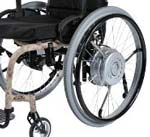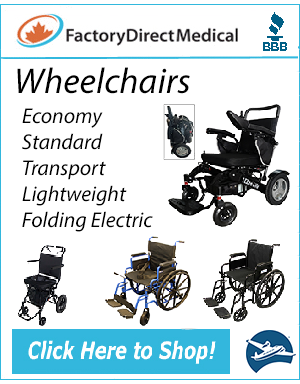
Manual Wheelchair Power Assist Devices
Power assist devices can be great options for people who travel a long distance everyday or even occasionally and want to reduce the effort required and maintain there stamina. Power assist devices for manual wheelchairs are ideal for those who lack the strength to efficiently propel their wheelchair over the distances required or have problems associated with their arms and/or shoulders that reduce their independence.
While many people may move to a conventional power wheelchair when faced with propulsion problems while using their manual wheelchair, power wheelchair present some problems that are not easily overcome. Power wheelchair rarely fold for storage and loading into smaller vehicles and when they do, they tend to be heavy and awkward to manage where as a manual wheelchair with power assist devices can often be disassembled, folded and loaded into a car by the user without anyone else's assistance.
Currently, as far as I know, the only type of power assist devices available on the market in North America are the power assist wheels. There have been other power assist devices in the past but they were nowhere near as functional, reliable or convenient as the power assist wheels.
Power Assist Wheels

Quickie XTender
Power Assist Wheels
Power assist wheels appear similar to conventional wheelchair wheels but have motors built into the hubs of the wheels to enhance the user's power when propelling the wheelchair. Power to the power assist wheels can be turned off when not needed to conserve battery power, the wheels can be easily removed from the chair completely and the original wheels reinstalled without tools if required.
In order to be able to use power assist wheels the wheelchair user must have the use of both hands and be able to control the wheelchair to some degree without the power assist wheels installed. When the power assist wheels are in place on the wheelchair the user controls and propels the chair as they normally would and the wheels reduce the effort required for use.
How the power assist wheels function:
When the wheelchair user pushes on the hand rim, the hand rim on the power assist wheels senses the pressure exerted and signals the motor in the wheel hub to start turning in the same direction the user is pushing. If the user pushes the rims in a forward motion the wheelchair is propelled forward by the motors and if the user pulls the hand rims back as if to back up the wheelchair the motors are signalled by the hand rims to turn backwards and propel the wheelchair backwards. Because each wheel has its own motor and is controlled independently by its own hand rim, the user can push each wheel in an opposite direction to turn the wheelchair as they normally would but will be assisted by the motors throughout the turn.
When the wheelchair users remove their hands from the hand rims or stop exerting pressure either forward or backward on the hand rims the motors stop running. Because of the sensitivity of the hand rims and the power assist wheel motors some training and practice using power assist wheels is required for the wheelchair user to be proficient and safe during use. Anti-tippers should be used on wheelchairs to prevent accidental rear ward tipping when the power assist wheels are in use.
Power assist wheelchair wheels are generally accessories that are purchased in addition to the wheelchair during the initial purchase or can be added to most manual wheelchairs as after market products.



 Online Vendors
Online Vendors  US Online Vendors
US Online Vendors 

